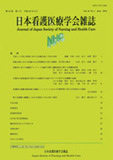Japanese
English
- 有料閲覧
- Abstract 文献概要
- 参考文献 Reference
要旨
高齢者に対する足趾の爪ケアを含むフットケアの今後のあり方を検討することを目的に、特養を利用する高齢者の足趾の爪ケアに対する看護職の認識を明らかにした。データ収集は、独自に作成した質問紙を用いて、2012年6月から7月に郵送法による無記名自記式で行った。分析対象は224名で(回収率23.9%)、看護の責任者・副責任者が85.3%で、施設に認知症ケア専門士関係の資格者有りは24.1%、認定看護師1.3%、フットケア指導士0.4%であった。異常のない足趾の爪ケアの実施者は、気が付いた者(70.1%)が最も多く、足趾の爪ケアのマニュアルがある施設は5.8%、足趾の爪ケアについて相談できる保健医療職者がいる施設は58.9%で、医師と看護師がともに半数近くを占め、フットケア指導士は1.5%であった。足趾の爪ケアに対する学習ニーズと特性との関係を比較した結果、足趾の爪ケアのマニュアルがある施設は【フットケア全般】【安全な足趾の爪ケア方法】【フットケアにおける裁量権の範囲】で、足趾の爪ケアについて相談できる保健医療職のいる施設は【フットケア全般】と【フットケアにおける裁量権の範囲】で、学習の必要性の認識が有意に高値であった。また、足趾の爪ケアの課題を特性ごとに比較した結果、足趾の爪ケアのマニュアルがある施設では【認知症高齢者に対する足趾の爪ケアの知識・技術の欠如】と【組織体制の未整備】が、足趾の爪ケアについて相談できる保健医療職者のいる施設では【相談できる専門職者の欠如】と【組織体制の未整備】について、施設の課題と認識している割合がそうでない施設よりも有意に高かった。以上をもとに、高齢者に対する足趾の爪ケアを含むフットケアの今後のあり方を検討した結果、①介護職と看護職の連携強化を基盤とした足趾の爪ケアの運営体制を整備していくこと、②看護の基礎・卒後教育においてフットケア教育の充実化を図ること、および、③フットケア指導士や特定看護師等の看護専門職者の活動範囲拡大の必要性が考えられた。
Abstract
The aim of present study was to elucidate nurses awareness of toenail care for users of welfare facilities for the elderly requiring long-term care(special nursing homes for the elderly) in order to discuss future approaches to foot care for the elderly. Data were collected by conducting an anonymous self-report survey using an original questionnaire sent by mail in June and July 2012 on nurses at one randomly selected special nursing home for the elderly from a total of 940 nationwide. Analysis was performed for a total of 224 nurses(response rate, 23.9%), including nursing managers and assistant managers(85.3%). Among the facilities, 24.1% had staff members who were certified as "Dementia Carer Qualified" by The Japanese Society for Dementia Care, 1.3% had certified nurses, and 0.4% had foot care educators recognized by the Japanese Society for Foot Care. Toenail care with no abnormalities was the most commonly implemented by those who noticed it(70.1%). A total of 5.8% of facilities had a manual for toenail care, while 58.9% had healthcare professionals who offered consultations regarding toenail care; nearly half(50%) of these professionals were physicians and nurses, while a small percentage(1.5%) were foot care educators. Comparison of relationships between learning needs for toenail care and characteristics showed that recognition of learning needs was significantly high for "foot care in general" and "safe toenail care" at facilities which had a manual for toenail care and for "foot care in general" and "discretion range of foot care" at facilities which had healthcare professionals who offered consultations regarding toenail care. In addition, comparison of issues in toenail care by characteristics showed that, in regard to "lack of specialist knowledge and skills for demented elderly" and "lack of establishment of organizational systems" at facilities that had a manual for toenail care and "lack of healthcare professionals offering consultations" and "lack of establishment of organizational systems" at facilities that had healthcare professionals who offered consultations regarding toenail care, the proportions of nurses who recognized these items as facility-specific issues were significantly higher than at other facilities. These findings suggest the following: 1)management of organizational systems for toenail care based on enhanced cooperation between care staff and nurses; 2)promotion of foot care education in basic and postgraduate nursing education; and 3)expansion of the range of activities performed by nursing professionals, including foot care educators and specialist nurses.
Copyright © 2014, Japan Society of Nursing and Health Care All rights reserved.


